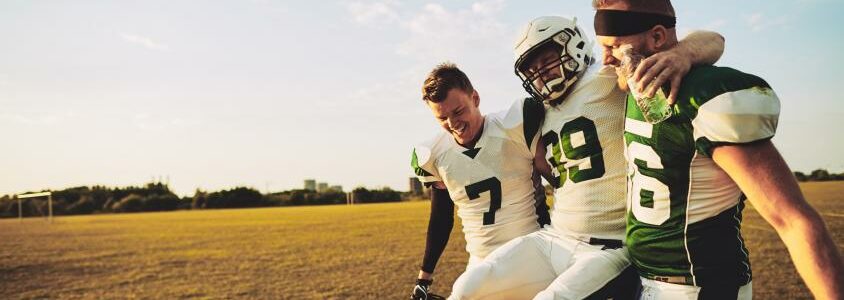
In recent years, doctors have begun to see a significant increase in overuse injuries in children as young athletes begin specializing in a single sport at younger ages. With this specialization, we see an increase in overuse injuries that are caused by repetitive trauma to bones, tendons and joints. Overuse injuries occur gradually over time, when an athletic activity is repeated so often, areas of the body do not have enough time to heal between playing.
Sports participation promotes the physical and emotional well-being of children, and also encourages the lifelong habit of exercise. Although the benefits of athletic activity are significant, too much activity can lead to injury.
Because young athletes are still growing, they are at a greater risk for injury than adults. The consequences of overdoing a sport can include injuries that impair growth and may lead to long-term health problems.
When a young athlete repeatedly complains of pain, a period of rest from the sport is necessary. If pain persists, it is important to seek proper medical treatment. To ensure the best possible recovery, athletes, coaches and parents must follow safe guidelines for returning to the game.
What is an Overuse Injury?
Overuse injuries are injuries caused by repeated strain on a particular area and typically occur in soft tissue areas like muscles, tendons and ligaments, or in the joints. Most of the time an overuse injury develops gradually over time rather than in a single moment like other injuries.
One of the key causes of overuse injuries is taking on too much too soon. This can happen when an athlete begins a workout at full speed before his or her body is ready or even when a person pushes too hard for a long period of time without proper rest. Both of these occurrences can lead to overtraining syndrome, which taxes the body and leaves people vulnerable to overuse injuries.
Overuse injuries can sideline an athlete, leading to diminished range of motion, pain and discomfort, and significant downtime while they attempt to recover.
What Are the 4 Stages of Overuse Injuries?
Overuse injuries happen in almost all youth sports including soccer, lacrosse, volleyball gymnastics, basketball, track and field, cheerleading, swimming, golf, and more. According to the American Academy of Pediatrics, half of all sports medicine injuries in children and teens are from overuse. They describe overuse injuries in these stages:
- Pain in the affected area after physical activity
- Pain during physical activity, not restricting performance
- Pain during physical activity, restricting performance
- Chronic, persistent pain, even at rest
Common Risk Factors
Watch for the following risk factors when considering overuse injuries.
- Imperfect mechanics
- Year-round training
- Underdeveloped strength and conditioning
- Lack of pre-work and post-work stretching
Why Are Overuse Injuries More Serious in Young Athletes?
Children and adolescents have bones, muscles and tendons that are still growing and developing. And while the growing body often adapts and heals quicker than an adult’s body, many young athletes may not recognize signs and symptoms of injury as early, which lead to a more serious injury. Often bad technique, such as pitching a baseball, if not corrected can also lead to more serious ligament injury as an adult, such as a “Tommy John” ligament (ulnar collateral ligament) tear.
How to Prevent Overuse Injuries
Athletes should stay away from excessive training programs that could be harmful. Here are guidelines to help prevent overuse injuries by promoting a healthy balance of activities.
Prepare
- Athletes should have a pre-participation physical evaluation (PPE) to make sure they are ready to safely begin the sport. The PPE should be incorporated into the athlete’s well-child visit in the medical home. However, it may need to be performed at a separate visit. The best time for a PPE is a minimum of 6 weeks before the beginning of the season to allow for any extra evaluation or rehabilitation.
- Athletes should maintain a good fitness level during the season and offseason. Preseason training should allow time for general and sport-specific conditioning. Also important are proper warm-up and cooldown exercises.
Play Smart
- Athletes should avoid specializing in one sport before late adolescence. Children should be encouraged to try a variety of sports.
- Participation in a particular sport should be limited to 5 days per week.
- Athletes should sign up for one team and one sport per season.
Rest
- One or two days of rest each week and longer breaks throughout the year are beneficial to avoiding overuse injuries.
- Athletes should take a combined 3 months off per year from a specific sport (may be divided throughout the year in 1-month increments). The athlete should remain physically active during that time.
Training
- Increases in weekly training time, mileage, or repetitions should be no more than 10% per week.
- Cross-train. Athletes should vary their endurance workouts to include multiple different activities, like swimming, biking or treadmills.
- Perform sport-specific drills in different ways.
Contact Ventura Orthopedic Today
No matter your child’s ability or interest, there are safe ways to foster a love of sports. If you have a question about your child’s sports involvement, talk to your child’s provider or contact the experienced and dedicated sports medicine doctors and surgeons at Ventura Orthopedics today.
Our team works together to design age-appropriate, individualized treatment plans that help young athletes get back in the game as quickly and safely as possible. We have the only program in the entire region that cares for multiple professional and college teams with the same physicians and experts who care for your young athlete.
If you are concerned about sports related injuries affecting your child, talk to the experts at Ventura Orthopedics today. Call us today at 800-698-1280 to schedule an appointment.

